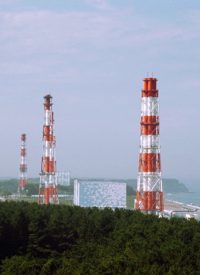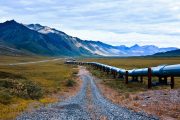
Almost eight months after a 9.0 magnitude earthquake and devastating tsunami struck Japan, killing or injuring more than 25,000, the death toll from radiation exposure at Japan’s storm-ravaged Fukushima Daiiche nuclear power plant (pictured at left, in 2002) stands at zero. Gregory Jaczko, chairman of the U.S. Nuclear Regulatory Commission, admitted as much on Monday in Washington during a roundtable discussion entitled “Fukushima: Lessons Learned,” an event sponsored by Georgetown University and the American Association for the Advancement of Science.
When a reporter from CNSNews.com asked him about radiation exposure deaths, Jaczko first jokingly tried to pass the question off to another panel expert but then acknowledged, “There have been no fatalities that we’re aware of that are directly related to radiation exposure.” He went on to explain that some workers received abnormally high levels of radiation after the disaster both at the plant and through contact with contaminated water, but “nothing that is going to lead to an immediate loss of life.”
These results prove what experts have predicted since the quake and tidal wave hit Japan’s Pacific coast in March: No one would die from radiation as a result of the incident. Despite this and Japan’s 20-kilometer (12.4 mile) evacuation zone at Fukushima, on Monday Jaczko also defended his original decision to implement a zone four times as large (80 kilometers or 50 miles) for Americans in the area. He said he now knows his initial fears were unfounded, though he excuses the reaction as an effort to protect American citizens.
Jaczko is not the only knee-jerker. Germany, Italy, and Switzerland have pulled the plug on atomic power in the media meltdown following Fukushima, to the detriment of Europe’s energy security and economic development. Reuters reported that a new study by the French computer consultancy Capgemini warns EU governments to start planning for an impoverished future. The article quotes energy analyst Colette Lewiner explaining,
Energy consumption growth in developing countries, the Fukushima accident, together with a slowdown in needed investments in energy infrastructure will have negative consequences in Europe on the security of energy supply and greenhouse gas emissions.
Germany’s nuclear energy exit bill passed in response to Fukushima has already turned the one-time electricity exporter into an importer, leaving itself and long-time customers such as France more dependent than ever on Russian gas imports. This coupled with the high price tag of alternative “renewable” sources promises to maintain the trend of soaring energy prices in Europe. “There is thus a real threat in some countries in keeping the lights on for the 2011/12 winter, and future winters,” Lewiner cautioned.
Anti-nuclear over-reacters fail to consider the consequences of an energy-deprived economy which would force developed countries back into third-world conditions where average life expectancy is as low as 47, and 50 to 80 percent of household income is spent on food. Yet the “any-level-of-radiation-is-not-safe” crowd irrationally insists on nixing nuclear at the expense of everything else. Bloomberg reported that at the height of the Japanese disaster, levels of radiation in Hong Kong, almost 2,000 miles from Fukushima, exceeded those in Tokyo only 135 miles away, which hardly amounts to a good excuse for shelving the most efficient, economical and indeed safest source of power on earth. Bob Bury, former clinical lead for the U.K.’s Royal College of Radiologists, rightly predicted, “The situation in Japan looks set to follow the pattern of Chernobyl, where fear of radiation did far more damage than the radiation itself.”
The future of nuclear in the United States is, at least, not quite so grim as that in the EU. “In general,” Jaczko divulged, “most people are going to be exposed to more radiation in medical diagnostic procedures than they ever will, certainly, from a nuclear power plant.”




